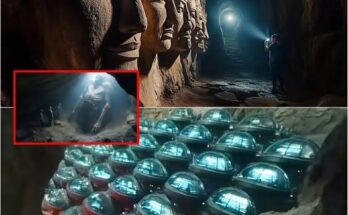A team of archaeologists has made a discovery that has shaken the world of Egyptology: the first royal tomb in more than a century, since the discovery of Tutankhamun’s tomb in 1922. This time, the protagonist is Pharaoh Thutmose II , a ruler who reigned some 3,500 years ago and whose history had been largely forgotten—until now.

The discovery took place in the legendary Valley of the Kings in Luxor , a sacred site where many of ancient Egypt’s most powerful pharaohs rest. It’s the same site where Howard Carter discovered Tutankhamun’s tomb just over a hundred years ago, making this new find even more symbolic and impactful.
Although the entrance to the tomb was first located in 2022 , it wasn’t until this year that excavations revealed something extraordinary: the remains of a tomb that, after multiple analyses and confirmations, was determined to be the final resting place of Pharaoh Thutmose II , an 18th Dynasty king.

Little known to the general public, Thutmose II was a New Kingdom ruler who briefly ruled Egypt. His reign is often overshadowed by figures like Hatshepsut, his wife and half-sister, who went on to become one of the most powerful pharaohs in history. However, this discovery could change our perception of Thutmose II and his role in ancient Egyptian history.
Experts hope the new findings inside the tomb will offer crucial details about his life, politics, religious beliefs, and lineage, providing a more complete picture of his reign.
Unlike Tutankhamun’s tomb, which was found almost intact, Thutmose II’s tomb has suffered severe damage over the centuries. Archaeologists believe evidence suggests that ancient flooding and the actions of grave robbers damaged much of its original structure and the artifacts it contained.
Still, researchers remain hopeful. “Although the tomb is badly damaged, it still contains a wealth of information that could revolutionize our understanding of Ancient Egypt,” one of the lead archaeologists told local media.
This discovery marks a pivotal moment for Egyptian archaeology. For decades, it was thought that there were no more royal tombs left to be discovered in the Valley of the Kings. The discovery of Thutmose II’s tomb raises the possibility that other pharaohs may still be buried deep in the Egyptian desert , waiting to be discovered.
Furthermore, this discovery puts Egypt back at the center of global interest, attracting researchers, historians, and tourists fascinated by the mysteries of the Nile.
Currently, an international team of archaeologists and Egyptologists is working painstakingly to excavate, preserve, and document the remains found in the tomb. Every object, every hieroglyph, every fragment of mural is a key piece in the puzzle of Egyptian history.
Experts are also using cutting-edge technology, including 3D scanners and X-ray analysis , to avoid damaging what little remains and to digitally reconstruct the tomb’s original appearance.
The discovery of Thutmose II ‘s tomb is not only an archaeological feat, but also an opportunity to relive the history of an almost forgotten pharaoh. It is a reminder that Ancient Egypt still has secrets to reveal and that history, far from being completely written, continues to surprise us with each layer of sand that is turned over.Review: Top 10 Cloud Services in the USA Cloud computing has transformed how businesses operate, offering scalable, secure, and cost-effective solutions for storage, computing, and application management. The U.S. leads the global cloud market, with providers delivering innovative services tailored to startups, enterprises, and everything in between. Below is a comprehensive review of the top 10 cloud service providers in the USA for 2025, based on market share, service offerings, and customer feedback. Amazon Web Services (AWS)AWS dominates with a 31% global market share, generating $24.2 billion in Q4 2023 revenue. It offers over 200 services, including compute (EC2), storage (S3), AI (SageMaker), and analytics. AWS’s 33 regions and 105 availability zones ensure low latency and high reliability. Its pay-as-you-go pricing starts at ~$0.0832/hour for a t3.large instance (2 vCPUs, 8GB RAM). Ideal for businesses needing scalability and cutting-edge AI tools. Microsoft AzureAzure holds a 24% market share and is the fastest-growing major provider, with 30% revenue growth in 2023. It offers 200+ services, including IaaS, PaaS, and SaaS, with strengths in AI, IoT, and enterprise integration. Azure’s pricing for a 2 vCPU, 8GB RAM instance (D2s v3) starts at ~$0.096/hour. Its hybrid cloud solutions and Microsoft ecosystem make it a top choice for enterprises. Google Cloud Platform (GCP)GCP, with an 11.5% market share, excels in AI, machine learning (TensorFlow, BigQuery), and data analytics. It offers 150+ services across 24 regions and 73 zones. Pricing for an e2-standard-2 instance (2 vCPUs, 8GB RAM) starts at ~$0.070/hour, with up to 57% discounts for committed use. GCP is favored by data-driven businesses and developers. IBM CloudIBM Cloud provides IaaS, PaaS, and SaaS with a focus on enterprise-grade security, AI (Watson), and hybrid/multi-cloud deployments. It serves industries like healthcare and finance, offering 170+ services. Pricing varies, but its pay-as-you-go model is competitive. IBM’s strong partner ecosystem and AIOps solutions enhance business transformation. Oracle Cloud Infrastructure (OCI)Oracle Cloud is gaining traction with its high-performance computing and database services. It offers cost-effective pricing, with a free tier and discounts for committed use. OCI’s focus on enterprise applications, like ERP and CRM, makes it ideal for large organizations. Its global network includes 40+ regions. DigitalOceanDigitalOcean targets startups and developers with simple, affordable cloud hosting. Plans start at $2.50/month for 0.5GB RAM, 10GB storage, and 1 vCPU. Its managed databases (PostgreSQL, MySQL) and monitoring tools ensure reliability. DigitalOcean’s free credits and Hatch program support early-stage businesses. VMware CloudVMware, now under Broadcom, specializes in multi-cloud and hybrid cloud solutions. It supports AWS, Azure, and GCP, offering consistent management across environments. VMware’s virtualization expertise and low-cost migration tools make it a top pick for enterprises modernizing data centers. SalesforceSalesforce focuses on cloud-based CRM and customer service solutions. Its Service Cloud automates workflows and integrates with AI for personalized customer experiences. With 1.5 million users, it’s a leader for businesses prioritizing customer engagement. Pricing is subscription-based, tailored to business size. CloudflareCloudflare is a CDN and security-focused provider, offering DDoS protection, DNS, and content delivery. Its user-friendly interface and integrations with WordPress and Shopify appeal to businesses needing fast, secure web performance. Pricing includes a free tier and pay-as-you-go plans. Linode (Akamai) Linode, acquired by Akamai, offers developer-friendly cloud hosting with transparent pricing and a free tier. It integrates with Akamai’s CDN for enhanced performance. Plans start at $5/month for 1GB RAM, 25GB storage, and 1 vCPU. Linode is ideal for SMBs and tech-savvy users. Choosing the Right Provider Selecting a cloud provider depends on your needs: AWS, Azure, and GCP dominate for scalability and enterprise solutions; DigitalOcean and Linode cater to startups; Salesforce excels in CRM; and Cloudflare prioritizes web performance. Compare pricing, scalability, and security features. Check reviews on platforms like Gartner or Forbes Cloud 100 for insights. As cloud spending grows (projected at $591.8 billion in 2023), ensure your choice aligns with long-term goals.






